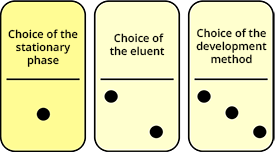Choice of stationary phase
The stationary phase is usually deposited on a support.
The support (thin layer) is inert, rigid or flexible (glass, aluminum, polyamide, etc.)
The stationary phase is generally mixed with a binder, which ensures adhesion to the support, and deposited in a thin layer.
The usual stationary phases are:
- silica
- alumina: neutral, acidic or basic
- cellulose (for very polar substances)
Case of silica (SiO2)n: its surface can be modeled with silanol groups Si-OH => it is a polar and protic material.
The polar molecules will thus be adsorbed and retained more strongly by the silica than the apolar molecules.
Different factors can be taken into account:
Grain size, specific surface area, pore volume and diameter, particle size distribution, presence or absence of fluorescence indicator, etc.
The most common TLC supports are silica plates of type 60 GF254: particle size 60, particle size 60, with a binder and a fluorescence indicator (mixed zinc and cadmium sulfide which fluoresces at 254 nm)





